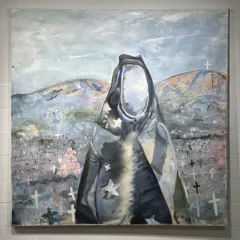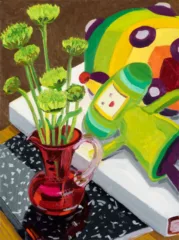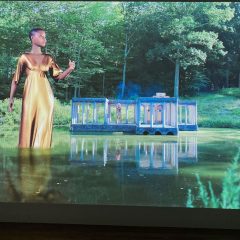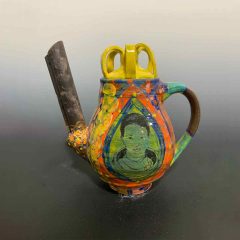Author’s Introduction
I visited Marilyn Holsing’s studio in the Crane Building in 2022. I had invited myself after seeing posts of her recent paintings and drawings on Instagram. It was such an exciting experience to see the dioramas in person, to navigate this fantastical world of plants and characters, and to hear more about the inventive world that she has created. It was such a pleasure to interview Marilyn, to dive deeper into the history and content behind her work.
Lauren:
Your inventiveness from dioramas to your drawings and paintings is so captivating – there is a realness to the magic and invention that is essential to your work. Can you elaborate a bit on what brought you to this method of working? Did you always invent imagery, or is it more deeply connected to your experience of the desert landscape in New Mexico? I personally remember my first trip to Arizona and feeling like I had landed on another planet.
Marilyn:
All of my studio work begins as vague postage stamp-sized drawings in my sketchbooks. As I make these drawings, I will find particular images to be compelling and will expand on these ideas until I develop an infatuation with some. It is from these little drawings with one leading to another that my series begins.
Ever since graduate school my work has been narrative, usually but not always involving figures, and outdoor settings. The figures were usually invented until the Young Marie Antoinette (YMA) series. The drastic contrast of living most of my first 20+ years in Ohio as a “flatlander” and then moving to New Mexico made me more aware of the landscape, flora and fauna, and the west’s big sky, colliding with a return to the east. This has been reflected in my studio work when I first moved to Philadelphia I continued using a southwest landscape that gradually gave way to an eastern one with greenery. Over the years, I have endeavored to put these narratives into ‘real world’ settings.
By the way, I loved your comment about the ‘realness’ to my work.
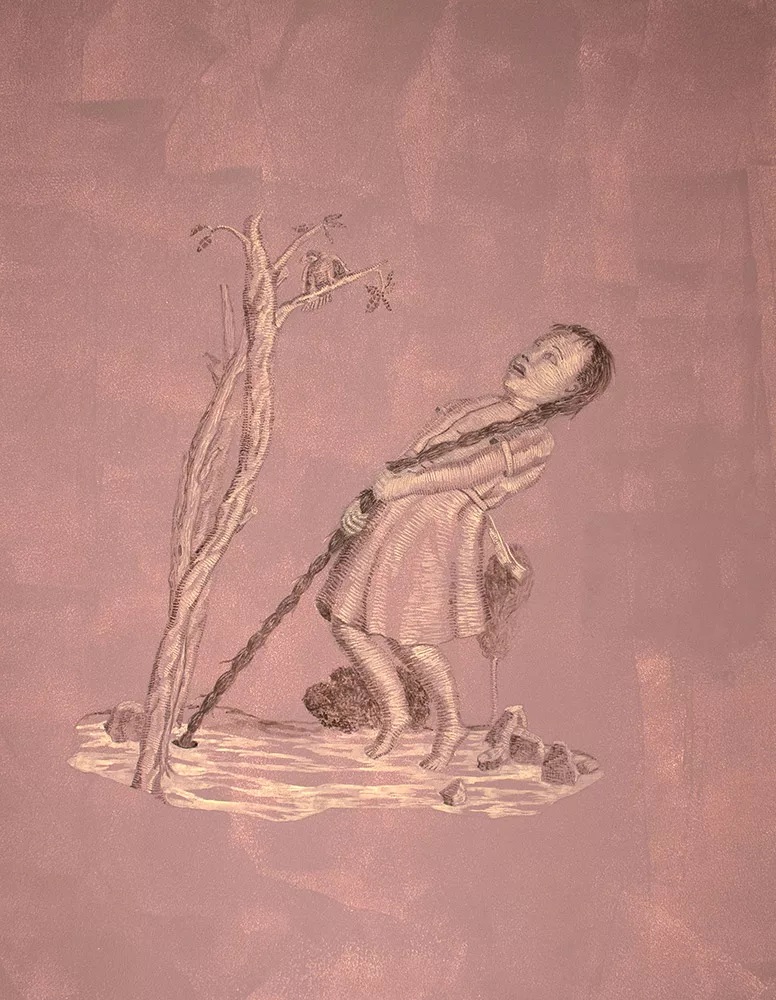
Lauren:
I know your Marie Antoinette pieces are also connected to Fragonard’s work – can you speak a bit about how and why this subject and character interests you?
Marilyn:
It has been a habit in my studio to work in series, one idea leading to others. The YMA series was preceded by a series about long-haired girls for whom their hair was an impediment: it was so abundant that sometimes 2 girls shared it, it formed a true beehive on a girl’s back, it grew into a hole in the ground, etc. A trip to Paris resulted in visiting Versailles and stumbling on to Le Hameau, YMA’s play farm. I had done no research before visiting but was aware of the myths surrounding her.
When I returned to the studio it dawned on me that Marie was a long-haired girl and I began exploring this idea leading to my infatuation. My reading revealed she was a fairly wild child growing up, she was the least favorite of her mother’s many children and was neglected. The young Marie was allowed to roam and ride horses on the family estate, in contrast to the commonly held notion that she was always surrounded by luxury. Obviously, the play farm was an effort to bring her some comfort. Of course, this brought me to Fragonard and other Rococo artists of the same time period. Some aspects of the imagery I used in the YMA paintings derived from Rococo painters and their grand fables enhanced by the dramatic evocative foliage. As the YMA series was drawing to an end, honoring Fragonard seemed logical.
Frequently I am drawn to contradictory ideas, such as, the myths around YMA contrasting with the truth, or the Rococo imagery of rugged romantic landscape populated with opulently dressed frolicking figures frequently accompanied by flying children (the putti).
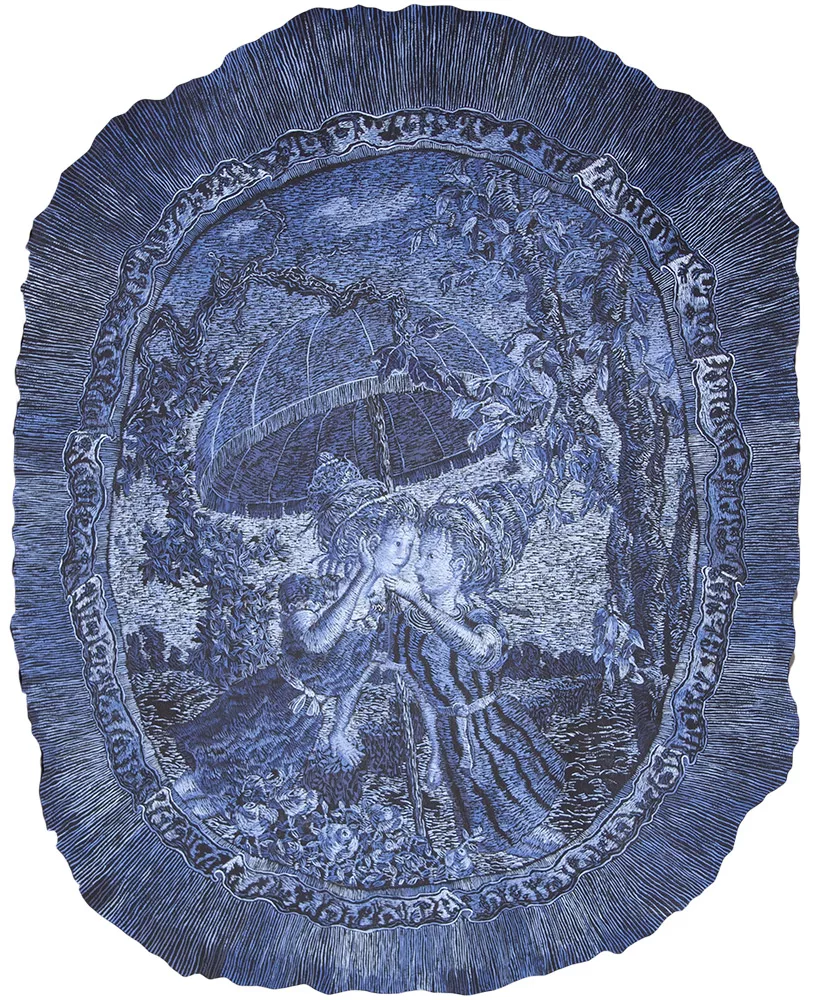
Lauren:
The dioramas are materially exciting, they exist as relief-like pieces against a wall, and free-standing sculptures with lights, projectors, movement, sound, etc. Can you tell us more about them- like their construction and their influences?
Marilyn:
For a few years I was working with a series about an invented version of young Marie Antoinette in reduced circumstances updated to more modern times working on paper with acrylic and Flashe paints, making the images from tiny strokes of color akin to embroidery stitches.
A failed drawing which I cut out, led me to the first dioramas. By standing this piece up I created a proscenium arch, soon other elements were added in front and behind. Before long it was growing in complexity leading to several questions like- How to display it? And then what? The elements were constructed of paper supported by balsa wood limiting viewing to the front. The figures and other elements were painted using the same small strokes as I was using in my other work on paper. Finding a way to ‘animate’ these dioramas led me to create an animation of moving shadows of clouds and birds with sound projected across the top of the piece.
I had the opportunity of a one-person show coming up at Gallery Joe in Philadelphia and putting these dioramas in a corner of the gallery’s vault made sense. I designed two bases that would fit into the corner as well as a cover to disguise the suspended projectors that were needed. The second diorama was about Marie Antoinette’s maids, of course gossiping about their queen and a friend very generously translated a script I wrote into French and we recorded her students reading it.*
The limitations of paper started my experiments with clay, paint, and wire making three-dimensional figures with clothing to allude to the rococo. About this time I saw Eve Sussman’s ‘Thirty Seconds at Alcazar’ a video of a tableau vivant of Velazquez’s “Las Meninas”, which spurred me to think about the drama in Fragonard’s “The Progress of Love” series and could I make a diorama loosely based on this series of 12 paintings? This was not an arbitrary decision but since I love Fragonard’s storytelling it was a logical choice. I chose two paintings to concentrate on, “The Pursuit” and “The Meeting”, putting them back to back so they could share the same forest. The couples in my dioramas are the same which is not true of the originals. I used animatronics allowing some parts to move subtly and unpredictably, as well as incorporating sounds of nature and laughter and a video of a series of waterfalls. The piece was 8 feet tall, 8 feet long, and 4 feet wide. The development of this was supported by a generous Independence Foundation Fellowship.*
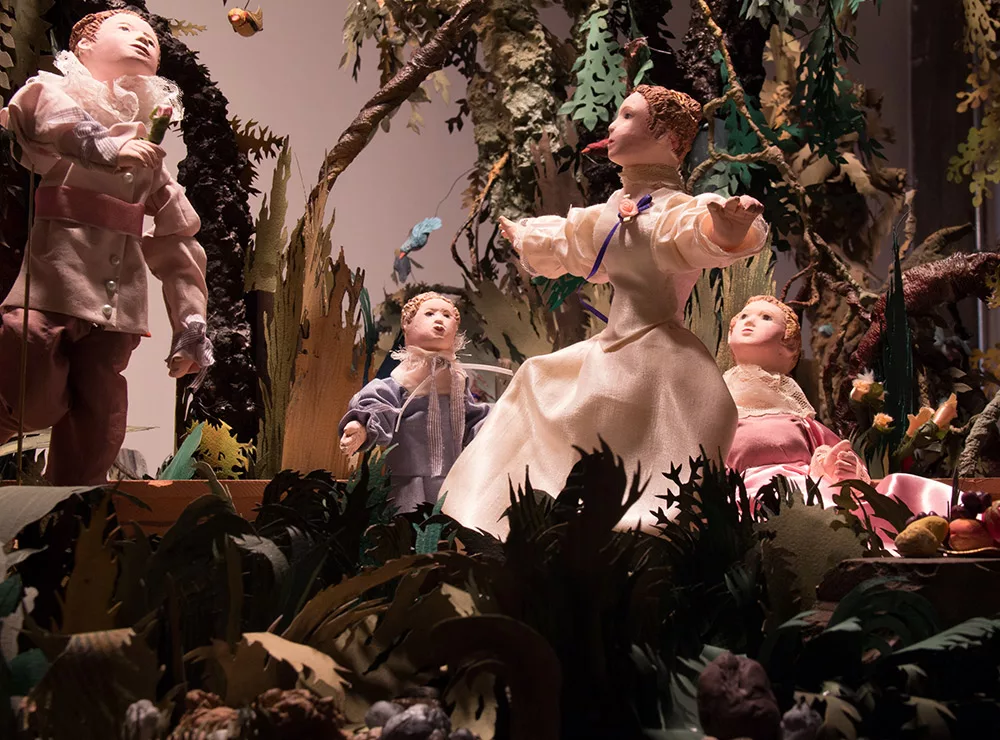
Lauren:
I love the feeling that they all have of being this big person looking into these strange worlds. They create an exciting exploratory feeling that feels so rewarding to the viewer. When taking in a work that is free-standing the viewer really has time to notice all of these exciting details, be surprised by the movements-building narrative as they experience the work. How have the dioramas evolved over time in subject and narrative?
Marilyn:
Even though I have continued to draw and paint, dioramas have continued to be a part of my studio practice. Recent ones are based on my own tales although the figures and settings still relate to rococo painting. One of the things that has fascinated me is the putti’ appearing to be harmless hovering in paintings as harbingers of peace and love. It has always left me wondering where do they come from and how do they live and do they ever grow up and do they die? In the diorama “Table Tableau” there is a small army of putti who are not so benign. They are hiding in a thick forest about to pounce on three unsuspecting picnickers and help themselves to a sumptuous snack. This scene takes place on a table like surface supported by cabriolet legs mounted on a parquet clad platform looking as though it could come from a living room.
While the theme is similar, a very different diorama is “Peepshow” which can only be seen through a series of ‘spy glasses’ made to look like logs piercing a forest wall. The spy glasses have a variety of lenses in them causing the space to look deeper than it really is, there is even a periscope. Inside glimpses can be seen of a picnicking couple being annoyed by putti and sleeping putti. The figures are made from clay, paint, wire, and cloth and the trees from wood, plaster, and paint. The total scene cannot be viewed, only small sections of it.
While working with these various figures I became more aware of facial expressions and began studying faces in various paintings, supplemented by internet images and began a series of busts 6 inches tall that I placed on little furniture legs. Like traditional busts they had no arms and hands relying alone on their faces for emotions. Recently I started putting these in groups in landscape settings giving them a narrative context and placing them in glass cloches.
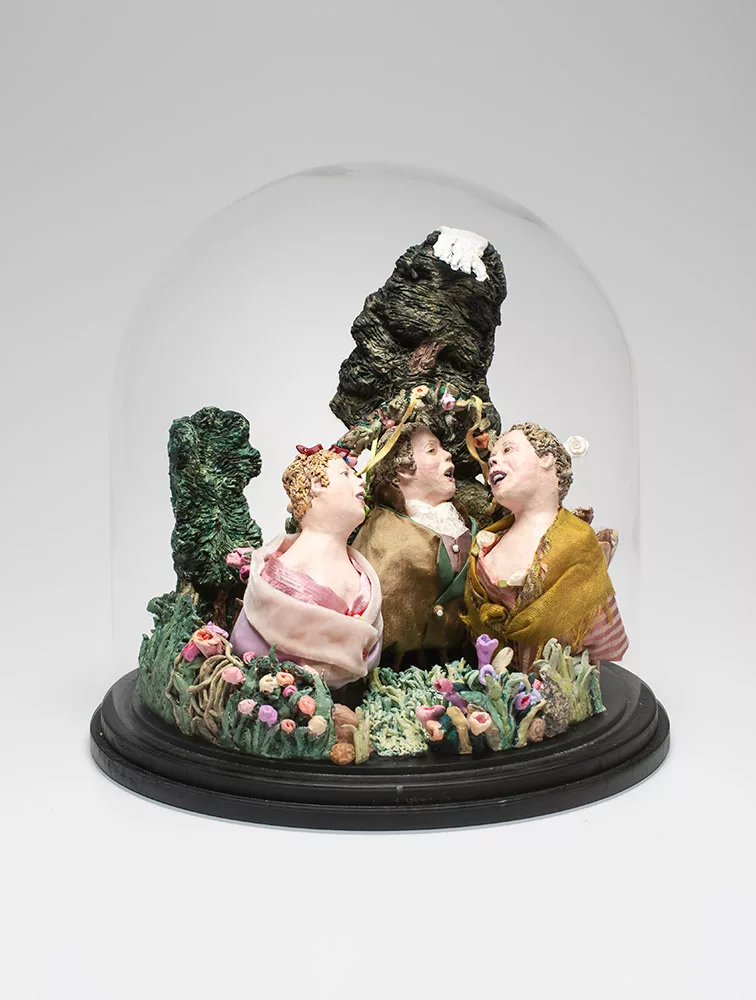
Lauren:
I’d love to talk about what you’re working on in your studio right now. Your compositions of invented plants feel just as much like an interaction of characters as the figurative works. How do you think about and create these works? Do they represent a different kind of narrative exploration?
Marilyn:
After ‘living’ in YMA’s world for some time, I wanted to break away; I assigned myself the task of creating narratives without figures but still anchored to the land. This challenge has led me to this new work of landscapes, “twisted and manipulated into places where an unknown narrative could take place, in place of the figure, the land, the flora, rocks, branches, and puddles become metaphors for the anthropomorphic.” Developing these ideas in gouache led me to return to oil paint for the first time in at least fifteen years affording me the joy of exploring color and texture in a way I haven’t for a while.
Foliage of various sorts has popped up in my work for years and continues to; not odd, since I am a gardener, as was my mother. Additionally, I have always been fascinated by the work of naturalist illustrators, such as Audubon, Thornton, etc., and the forest still lifes of painters such as Rachel Ruysch and Otto Marseus von Schreick. The imagery in these recent paintings partly comes from trying to understand the sway these illustrations and paintings hold over me, even the most sentimental ones, for reasons I can’t verbalize. Making art has always been a revelatory process for me since I work without a plan relying on intuition. The source for these plants is mostly my imagination, supplemented by printed imagery and direct observation. It is not unusual for me to work with images without firmly knowing what I am doing with them, which is true with this recent work.
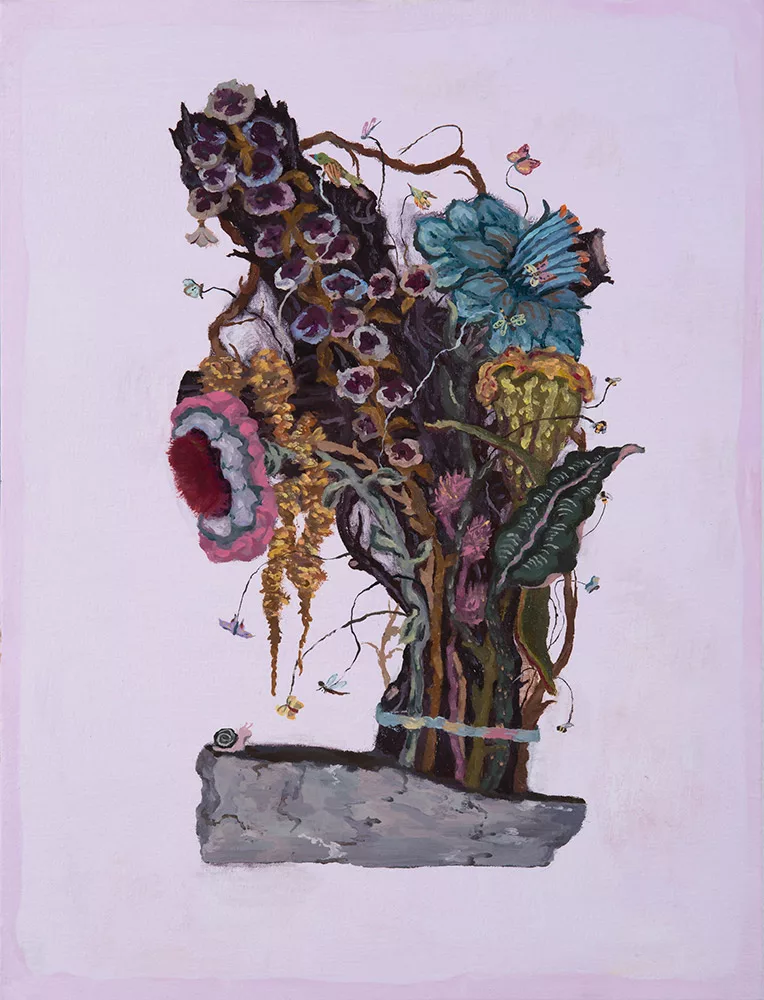
Lauren:
Thank you so much Marilyn, this has been such a great conversation. It’s so exciting to hear more about your work. Is there anything you’d like to conclude this conversation with?
Marilyn:
My imagined worlds don’t obey the rules of the real world but operate in liminal places where they mesh and collide. My sketchbooks are the heart and soul of my studio work, they are where I can explore the ‘what ifs’ of the collision between out there and in here that lead to other work in any medium..
“Everybody who writes is interested in living inside themselves in order to tell what is inside themselves. That is why writers have two countries, the one where they belong and the one in which they live really. The second one is romantic, it is separate from themselves, it is not real but it is really there.” Gertrude Stein, Paris France.
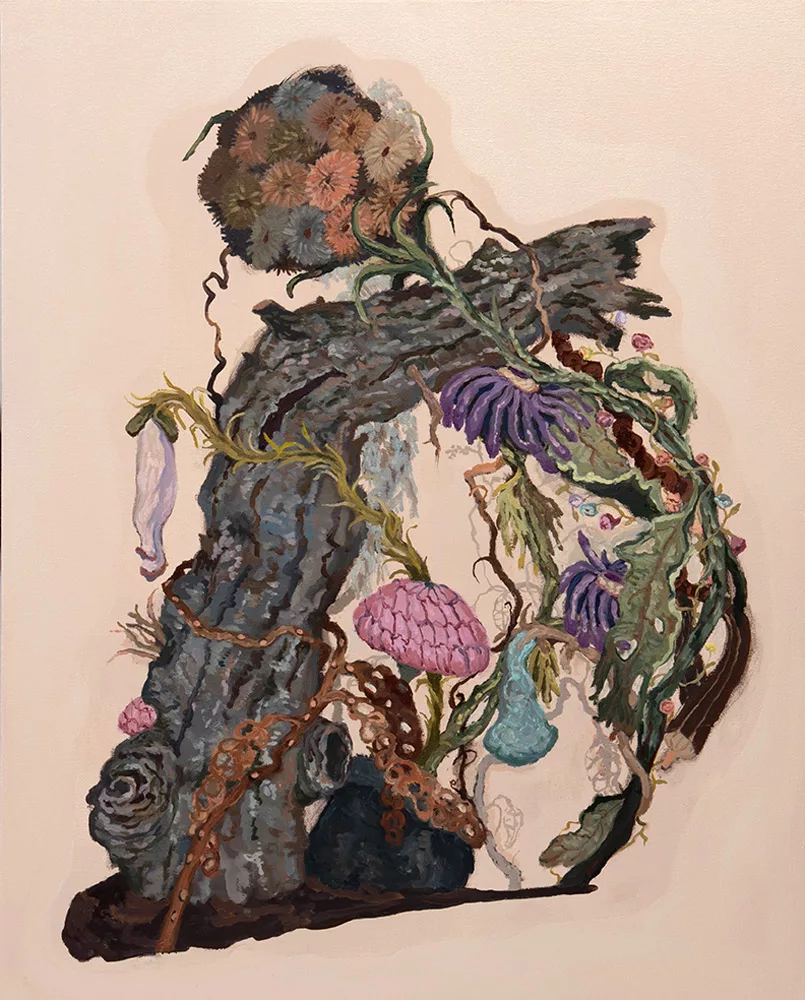
Find out more info about Marilyn on Artblog and connect with her Youtube channel as well:


